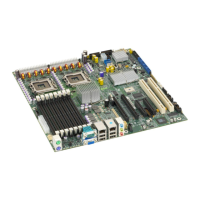Appendix C: Troubleshooting
This chapter helps you identify and solve problems that might occur while you are using
the system.
For any issue, first ensure you are using the latest software.These software updates
include updates for BIOS, the baseboard management controller (BMC), and the hot-swap
controller (HSC). See “Additional Information and Software” on page viii for a link to the
software updates. In addition to the system firmware and files, also update any drivers
used for components you have installed in your system, such as video drivers and network
drivers.
Intel provides a package called the “Platform Confidence Test” that may help with your
diagnostics. See “Additional Information and Software” for a link to this software.
If you are unable to resolve your server problems on your own, see “Getting Help” on
page 45 for assistance.
System Boot Quiet Time
The power-on self test (POST) process includes a quiet time, during which the system
may appear to be hung. This may last as long as 40 seconds. Do not power off or reboot
the system during this time. The POST LEDs will indicate activity. They may alternate
blinking between amber and green. When the quiet time completes, the status LED will
change to solid green.
Resetting the System
Before going through in-depth troubleshooting, attempt first to perform reset your system
using one of the methods below.
Table 7. Resetting the System
To do this Press
Soft boot reset to clear the system memory and reload the operating
system
<Ctrl+Alt+Del>
Clear system memory, restart POST, and reload the operating system Reset button
Cold boot reset. Turn the system power off and then on. This halts power
to all peripherals, clears system memory, restarts POST, reloads the
operating system, and halts power to all peripherals
Power off/on
button

